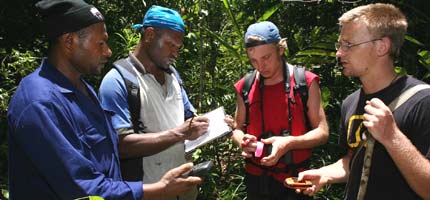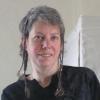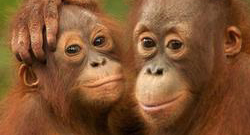
In the remote forests of Papau New Guinea, illegal and destructive logging continues to threaten both the local communities and the fragile ecosystem. But today Greenpeace launched a major initiative to help indigenous tribes establish their rights to the land they have occupied for generations.
Got Google Earth?See the location of the Global Forest Rescue Station by downloading a placemark file.
You need Google Earth to use this file - get it here.
At the invitation of the local tribes, Greenpeace have established the Global Forest Rescue Station on the western edge of Lake Murray, deep in the Paradise Forests which stretch through Papua New Guinea and across South East Asia. From the Station, Greenpeace volunteers from around the world will help members of the Kuni and Begwa tribes mark out the boundaries of their lands to protect it from loggers.
Although by law 97 per cent of Papua New Guinea is recognised as being owned by the customary landowners who live there, many tribal boundaries have never been recorded. Until this is done the land is effectively up for grabs and even though the logging companies are supposed to get agreement from landowners before they can move in, in practice this rarely happens.
Even when it does, the local communities see very little of the huge profits generated by the loggers but the forest cannot sustain their operations for much longer. For each tree felled for timber no less than seventeen others are destroyed, not to mention the impact on the fantastically diverse wildlife that the trees support, and the area can take decades to recover.
"Our forest is like a supermarket and our survival depends on the forest. The forest gives us our homes, our food and our medicine."Sep Galeva, Kuni clan leaderBut there is a solution. Boundary marking is the first step in allowing the customary landowners to use the forest as they have always done, with low impact techniques that neither deplete or destroy its precious resources. The Station will help both tribes, as well as the Pari tribe, mark out an expected 300,000 hectares of territory in the Lake Murray region.
The Station isn't just about mapping out land boundaries. Part of the work done there will be to promote small-scale community enterprises that help maintain the forest and bring greater benefits to the communities that live there such as ecoforestry.
Instead of wholesale destruction of the forest with large machines to extract the timber, portable equipment is used to minimise the impact. Trees are milled where they fall and are either carried along bush trails or floated out along rivers, and then strict guidelines and monitoring allow the forest to restore itself as quickly as possible.
The profits from this method of forestry are also much more than those that trickle down from the logging companies, between four to 10 times greater, all of which is shared among the local communities.
So with simple, community-based solutions the Global Rescue Forest Station will help protect the unique biodiversity of Papua New Guinea but with only one per cent of the forests under any kind of protection, there is still a long way to go.




